September itinerary in Japan Day 9 (Hokkaido Day 4)
(Monday, October 4)
Table of contents
1,Former Hokkaido Government Office Building
2,Sapporo Archives Museum (former Sapporo Court of Appeals)
3,Former Sapporo Agricultural School Performance Hall (Clock Tower)
6, Sapporo Fushimi Inari Shrine
Unfortunately, the Hokkaido University Faculty of Agriculture Second Farm was open from October 5, so I couldn’t visit it as planned in the itinerary. Therefore, I decided to go around Sapporo city from the Former Hokkaido Government Office Building. Also, I went to the Botanic Garden, Hokkaido University on October 2, so I didn’t go there on the 4th.
https://edokagura.com/en/local-cuisine/543/
1,Former Hokkaido Government Office Building
(8 minutes walk from Sapporo Station)
It is an American neo-Baroque architecture built in 1888. Designed by Hirai Seijiro, an national important cultural property. Personally, this is my favorite building. Looking at the former Hokkaido Government Office building, I realize that I have come to Hokkaido. Currently, it is scheduled to be completed in 2024 and is undergoing renewal work.

https://www.sapporo.travel/en/spot/facility/former_hokkaido_government_office/
2,Sapporo Archives Museum (former Sapporo Court of Appeals)
(17 minutes walk from the former Hokkaido Government Office Building)
Built in 1926, it is a national important cultural property. It is located at the western end of Odori Park. I visited after a long time. Looking at it again, I was impressed that it was a profound and wonderful building.
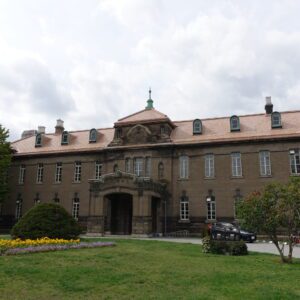
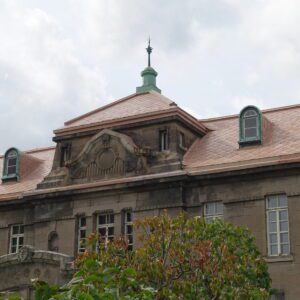
https://www.sapporo.travel/en/spot/facility/shiryokan/
Admission: Free
3,Former Sapporo Agricultural School Performance Hall (Clock Tower)
(5-minute walk from Odori Park Station)
It was built in 1878 as a performance hall (indoor gymnasium) in the middle of the schoolyard of Sapporo Agricultural College. It is a national important cultural property.
I took pictures from the two shooting spots introduced on the Sapporo City website.
First of all, it is a picture taken from the terrace on the 2nd floor of the building “Sapporo MN Building” across the road.
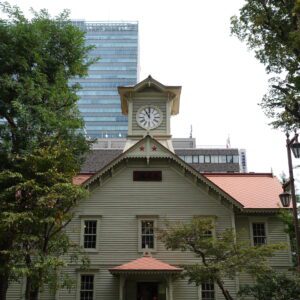
This photo was taken from the bicycle parking space of Sapporo City Hall, diagonally opposite the back of the clock tower.

Is it possible to avoid the impression of “three major disappointing sights in Japan” by devising the photo shooting location? My impression was that the clock tower was smaller in the old days, so the image improved a little.
This time, I didn’t visit the inside of the clock tower in order to go to the popular “Soup Curry” shop “CURRY YA! CONG” by the opening time.
https://www.sapporo.travel/en/spot/facility/clock_tower/
Admission: Yen 200 for adults, free for high school students and younger
4, Hoheikan
(13 minutes walk from CURRY YA! CONG, 6 minutes walk from Nakajima Koen Station)
After lunch, I visited Hoheikan according to the itinerary prepared in advance. Last year, I went to the summit of Mt. Moiwa, so this time I went to Hokkaido Jingu without going to the summit of Mt. Moiwa. In terms of time, you can also go to the summit of Mt. Moiwa according to the itinerary.
https://edokagura.com/en/local-cuisine/559/
Hoheikan was completed in 1881 as an accommodation facility. It is the only hotel built by the Meiji government and is a national important cultural property. The design was done by Yoshiyuki Adachi, one of the leading architects of the early Meiji era. It is a historical building where three emperors (Emperor Meiji, Emperor Taisho, Emperor Showa) were used as accommodations.

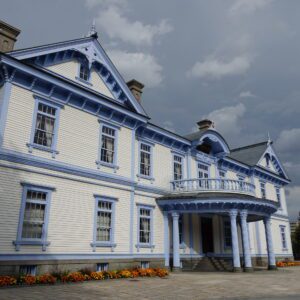
The decorations such as the chandelier inside the Hoheikan are also wonderful, so please take a look inside.
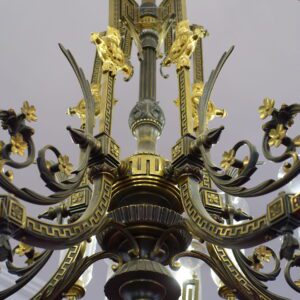
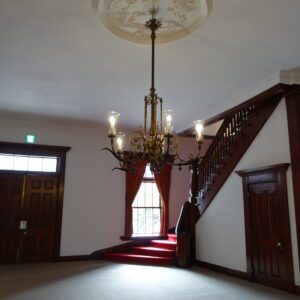
Please note that the reading of “豊平 Hohei, Toyohira” is complicated. In the case of Hoheikan and Hoheikyo, it is read as “hohei”, but in many other cases such as Toyohira Ward and Toyohira River, it is read as “Toyohira”. I don’t know why the readings are different.
“Akaboshi (red star)” in the center of Hoheikan is Goryosei, a symbol of the Hokkaido pioneer. There are also “Akaboshi (red star)” in the Former Hokkaido Government Office Building and the Former Sapporo Agricultural School Performance Hall (Clock Tower). Hoheikan’s “Akaboshi” is more conspicuous because “Akaboshi” is placed in a building based on pastel blue.
As an aside, Sapporo Lager Beer “Akaboshi” is also derived from Goryosei. “Akaboshi” was first manufactured in 1877 at the “Kaitakushi Brewery”. It was four years before the completion of Hoheikan. Perhaps “Akaboshi” was also drunk at Hoheikan.
Admission: Yen 300 for individuals, free for junior high school students and younger
https://www.sapporobeer.jp/lager/
5, Hassoan
(1 minute walk from Hoheikan)
It is said that the tea room was designed by Enshu Kobori (the lord of Bitchu Matsuyama Castle and later the lord of the Komuro feudal clan in Omi Province), a daimyo and tea master in the early Edo period. Enshu Kobori becomes a disciple who learned the tea ceremony from Oribe Furuta. Bitchu Matsuyama Castle is a national important cultural property and is one of the 12 existing castle towers. Hassoan was relocated to Sapporo in 1919 from Nagahama City, Shiga Prefecture. Hassoan is a national important cultural property.
Admission: Free


Autumn leaves had already begun on October 4th at Nakajima Park, so they may have fallen now.
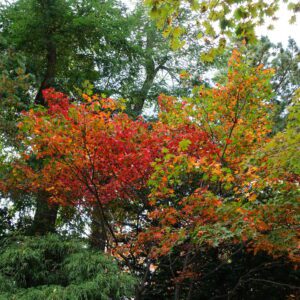
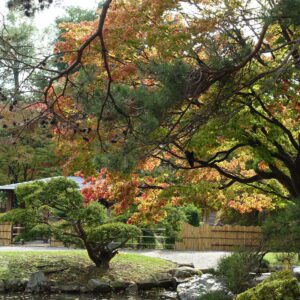
6, Sapporo Fushimi Inari Shrine
(6 minutes walk from Hassoan, Nakajima Koen Station, 17 minutes ride on the Sapporo streetcar, 13 minutes walk from Ropeway Iriguchi Station)
It was founded in 1884. There are 26 red torii gates in a row. Many people had bad manners in photography, so photography in the precincts was prohibited. Hanachozu was very beautiful, but I gave up because there was a signboard prohibiting photography. It was one of the most beautiful flowers I have ever seen.
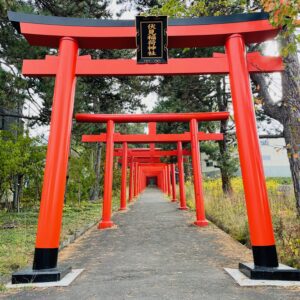
7, Hokkaido Jingu
(3 minutes walk from Sapporo Fushimi Inari Shrine, take the bus at Fushimicho Kodai Bus Stop, bound for Maruyama Koen Station 10 minutes ride, get off at Odori Nishi 25-chome bus stop, 14 minutes on foot)

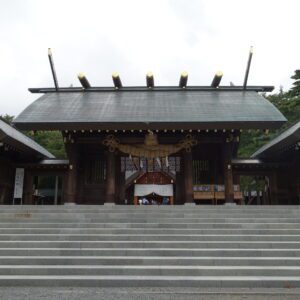 The day I visited was a weekday (Monday, October 4th), but the wedding ceremony was held at Hokkaido Jingu Shrine. The appearance of the bride and groom who entered the shrine maiden first was a very nice sight.
The day I visited was a weekday (Monday, October 4th), but the wedding ceremony was held at Hokkaido Jingu Shrine. The appearance of the bride and groom who entered the shrine maiden first was a very nice sight.
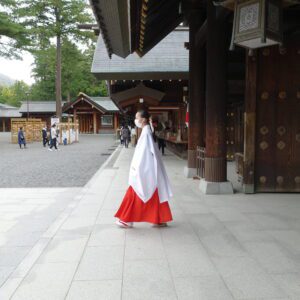
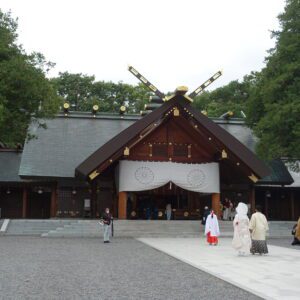
After Hokkaido Jingu Shrine, I had beer and dinner at Tanukikoji near Odori Park and headed to New Chitose Airport. It was a very fulfilling and enjoyable trip to Tohoku and Hokkaido.
Note: The departure / arrival times, fees, admission fees, etc. of transportation listed in the text are as of the time of writing the BLOG. They may change in the future, so please check for yourself when you go on a trip.
